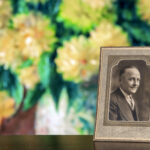

Don’t let this summer pass you by without a visit to one of our region’s best-kept secrets: The Samuel H. Ordway, Jr. Memorial Preserve
ABERDEEN, S.D. –Prairies seem to be everywhere in these parts. But if you’re only glancing at them through the window of your vehicle, you’re truly missing out on one of the most complex and beautiful ecosystems on the planet.
Just under 50 miles northwest of Aberdeen along Highway 10 lies the Samuel H. Ordway, Jr. Memorial Preserve. Nicknamed the Ordway Prairie, it’s a vast 7,800-acre grassland that seems to roll right up and touch the sky. It’s also home to a herd of 300 or so bison, as well as coyotes, foxes, badgers, a lively colony of ground squirrels, and a diverse collection of birds. And people are welcome, too. About 160 acres have been sectioned off as a visitor’s area. Here, guests can wander through the wildflowers, look closely at the insects, or listen for the calls of the meadowlarks. If you want more direction, the staff at the preserve are happy to organize educational outings for whatever your group is interested in, whether that’s birdwatching or identifying flowers. For Sportsmen, they have walk-in areas that are open during hunting seasons.
One thing that makes the Ordway Prairie so special is how its conservation efforts line up seamlessly with a common land use for this area. Mary Miller of Leola has managed the preserve for close to 20 years. She says taking care of the prairie all comes down to maintaining diversity among the plants that grow on it. “It’s a chain reaction because different insects like to eat different plants, and different birds eat different insects, so if you lose that diversity in the plants, it affects everything out here.” There are several invasive, nonnative species that threaten to out-compete and overrun the native plants. Grazing is one way to control this. When animals eat the grass, they naturally cut back the taller, invasive types that are overgrowing, allowing more sunlight to filter through to the low-growing species so they can survive as well. Mary explains, “Bison roamed the prairie for years, grazing and following fire and providing that natural disturbance the plants and animals here need. Today, we have cattle that can do that, and people can make a living raising cattle, so it’s a win-win.” Their resident bison herd grazes about half of the preserve, while they rent the remaining portion to a handful of local cattle ranchers. Funds earned from renting pastures to farmers and from producing buffalo meat are put back into supporting the preserve’s research and conservation efforts.
While it might appear flat and even from a distance, the Ordway Prairie is full of over 400 deep and shallow depressions that make up a rich wetland environment among the grasslands. Some of these “prairie potholes” are full only during wet years or in the spring. Others keep water year round. Just like having a variety of plants is important, having many wetland options is too. Mary says, “This whole area is known as the Duck Factory of North America because it turns out so many ducks for the whole continent. Since birds use the different kinds of wetlands during different points in their lifecycles, our diversity in wetlands contributes to the diversity in our wetland birds.”
Mary and David Losure are the only full-time employees at the Ordway Preserve. Many volunteers also help it operate, from undergraduate and graduate students to retired couples who’ve fallen in love with the prairie. Mary started coming to Ordway right after college as a seasonal helper in the summertime and jokes that she just kept coming back until they hired her as manager. She says, “Prairies are misunderstood. People drive by them and don’t even know what’s out there, and it’s definitely a system where you have to get out of your car and walk through it to really appreciate it.” She adds, “There are moments out here that make you really appreciate this country and how unique it is. We’ve had groups of businessmen and women, who probably normally wear suits every day, out here crawling around looking for bugs under rocks like they’re five years old again. That we’re able to offer that to people and have them learn about the prairie that way, that’s really the most special to me.” // –Jenny Roth
More information about the Samuel H. Ordway, Jr. Memorial Preserve can be found at www.nature.org, www.facebook.com/natureconservancysouthdakota,
or by emailing Mary Miller at [email protected].


























